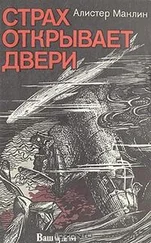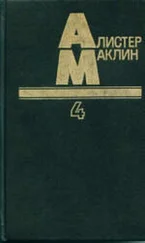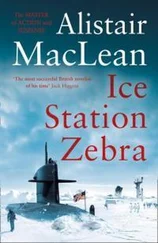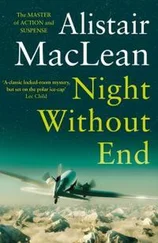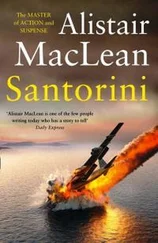Deakin lifted off the tarpaulin covering this box, rolled it, thrust it under his coat, picked up the grey box, doused the lamp and left, locking the door behind him. Even during the brief time he had been inside the supply wagon the visibility had become appreciably worse. It was as well, Deakin reflected, that they had the security of the railway lines to guide them on their way: in such weather, a horse and rider, or horses and coaches, would, like as not, have ended up in the depths of the ravine.
Lugging the heavy transmitter and now making little attempt at concealment, Deakin hurried along the length of the supply wagon and climbed up the front platform of the leading horse wagon. The door was unlocked. He passed inside, closed the door, lowered the transmitter, located and lit an oil-lamp.
Nearly all the horses were standing, the majority of them chewing mournfully on the hay from the managers bolted to the side of the wagon. They had little enough room to move in their individual stalls but seemed unconcerned about it. Nor did they show much concern for Deakin’s presence. Such few as bothered to acknowledge his presence looked at him incuriously, then as idly turned their heads away.
Deakin paid no attention to the horses. He was much more interested in the source of their food supply, a wood-slatted haybox by his right shoulder that reached almost to the roof. He removed the two top slats, climbed on to the top of the hay and burrowed a deep hole at the back, hard against the side of the wagon. He swung down to the floor, wrapped the transmitter in the tarpaulin, carried it to the top of the haybox, buried it deep in the hole and covered it with hay to a depth of almost three feet. Even allowing for the most evil mischance, Deakin reckoned, the transmitter should remain undetected for at least twenty-four hours: and twenty-four hours would be all he would ever want.
He doused the lamp, left and made his way to the rear end of the second coach. He shook out his coat on the platform, went inside, hung the coat on a hook in the passageway outside the officers’ sleeping cubicles and made his way forward, sniffing appreciatively as he went. He stopped and looked through an open doorway to his right.
The galley was small but spotless with an array of pots simmering gently on the wood-burning stove. The occupant, when he turned, proved to be a short and very plump Negro most incongruously dressed in a regulation galley uniform, complete even to the chef’s tall white hat. He smiled widely at Deakin, teeth white and shining and perfect.
‘Morning, sir.’
‘Good morning. You must be Carlos, the chef?’
‘That’s right.’ Carlos beamed happily. ‘And you must be Mr Deakin, the murderer. Just in time for some coffee, sir.’
Claremont by his side, Banlon stood on the footplate of the locomotive, examining the tender. He turned and leaned out.
‘That’s the lot. Full. Many thanks.’
Sergeant Bellew raised a hand in acknowledgment, turned and said something to his men, who at once trudged thankfully away in the direction of their coaches, being lost to sight almost at once in the whitely swirling gloom.
Claremont said: ‘Ready to roll then, Banlon?’
‘Just as soon as this snow-squall clears, Colonel.’
‘Of course. You said you wanted the brakeman to relieve you. This would be a good time.’
Banlon said very firmly: ‘I did say that, but this would not be a good time, sir. For the next three miles, I want Devlin right where he is.’
‘The next three miles?’
‘To the top of Hangman’s Pass. The steepest climb in all the mountains.’
Claremont nodded. ‘A brakeman could have his uses.’
Fort Humboldt lay at the head of a narrow and rock-strewn valley which debouched on to a plain to the west. The strategic position of the Fort had been excellently chosen. Behind it, to the north, was a sheer cliff-face: to the east and south it was bounded by a ravine, narrow but very deep, the eastern arm of which was traversed by a trestle railway bridge: the railway line itself passed east-west in front of the Fort descending slowly down the winding valley into the plain beyond. From the point of view of defence Fort Humboldt could not have been more advantageously located. It could be approached only across the bridge or up the valley; facing in either direction, a small group of determined and well-entrenched men could have easily held off ten times their number.
Architecturally, the Fort itself had no claims to originality. Built years before the completion of the Union Pacific Railway in 1869, it had to depend entirely on local building materials, and the plentiful stands of conifers provided unlimited supplies of that. The wooden stockade was built in the customary form of a hollow square with a boardwalk, about four feet from the top of the stakes, running the entire length of the inside perimeter. The heavy gate, facing both railroad and the river which wound down the valley, lay to the south; immediately inside the gate there was, to the right, the guard-house and to the left the store for weapons, ammunition and explosives. The entire eastern side of the compound was given over to stables. To the western side were the troops’ quarters and cookhouse; the northern side was given over to officers’ quarters, administrative and telegraph offices, sick bay and some spare accommodation for the invariably weary travellers who made Fort Humboldt a port of call with a not surprising frequency; it was a long long way from any other place.
Approaching the Fort from the west – up valley – were a group of weary travellers who were clearly looking forward very keenly to whatever the Fort might offer them in the way of shelter and hospitality. They were Indians, wrapped to the ears in an unavailing attempt to protect themselves from the biting cold and the thinly falling snow. Tired, very tired, they looked, but not as exhausted as their horses, who were literally trudging through the fetlock-deep snow. Of them all, only their leader, an unusually pale-faced and strikingly handsome Indian, seemed unweary. He sat very erect in the saddle. But then, the chief of the Paiutes always did.
He led his men through the open and unguarded doorway, raised his hand in a gesture of dismissal and headed across the compound, bringing up at a wooden hut with, above the door, the legend COMMANDANT. The Indian dismounted, climbed the few steps and entered, closing the door quickly behind him to keep out the swirling snow.
Sepp Calhoun was seated in Colonel Fairchild’s desk armchair, his feet on the Colonel’s desk, one of the Colonel’s cheroots in one hand and a glass of the Colonel’s whisky in the other. He looked up, swung his feet to the floor and rose, a most unusual gesture of respect on the part of Sepp Calhoun, who customarily showed no respect towards anyone. But then, people did not show disrespect to this particular Indian. Not twice.
Calhoun said: ‘Welcome home, White Hand. You made fast time.’
‘In weather such as this the wise man does not linger.’
‘All went well? The line to San Francisco–’
‘Is cut.’ Imperiously, almost contemptuously, White Hand waved away the proffered bottle of whisky. ‘We destroyed the bridge over the Anitoba gorge.’
‘You have done well, White Hand. You and your men. How much time do we have?’
‘Before the soldiers from the west could reach here?’
‘Yes. Not that there’s any reason to assume that they think that there is anything wrong in Fort Humboldt and will be coming here anyway. But chances we cannot take.’
‘The stakes are high, Sepp Calhoun.’ He thought briefly. ‘Three days. Not less.’
‘More than enough. The train arrives tomorrow between noon and sundown.’
Читать дальше
Конец ознакомительного отрывка
Купить книгу



